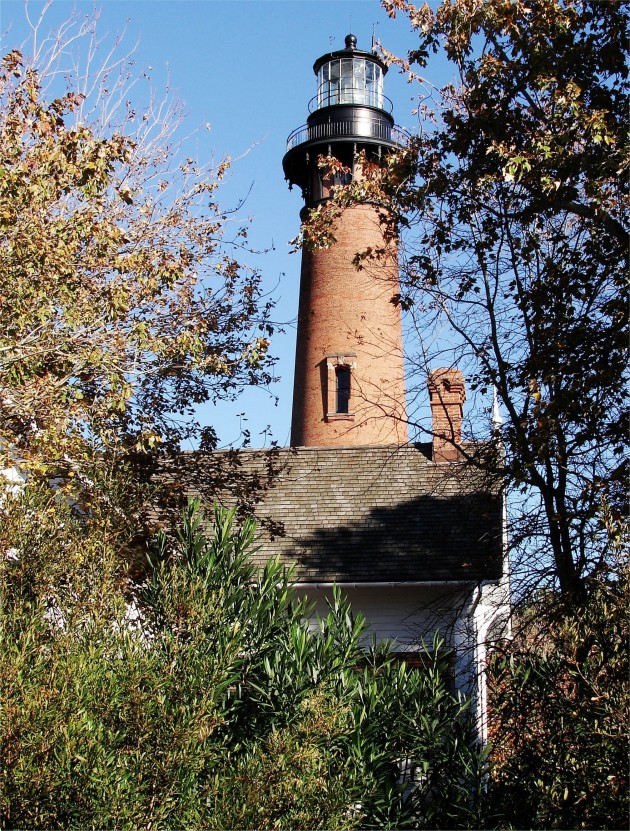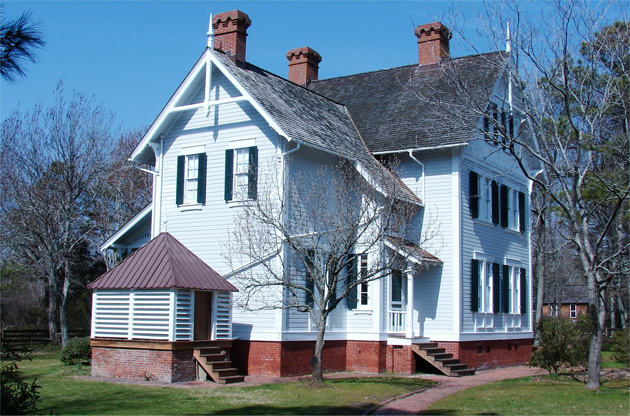Publisher's note: We believe the subject of history makes people (i.e., American people) smarter, so in our quest to educate others, we will provide excerpts from the North Carolina History Project, an online publication of the John Locke Foundation. This tenth installment, by Shane Williams, North Carolina History Project, is provided courtesy of the North Carolina History Project.
In the early-1870s, captains were having difficulty navigating along the choppy waters along the North Carolina coast, and cargo was being lost. So, Congress appropriated $178,000 and construction of the Currituck Beach Lighthouse began in 1873. It was completed on December 1, 1875.
The lighthouse stands at 162 feet, and the beacon flashes warning signals every twenty seconds. The lighthouse is distinct for its natural brick construction (Over one million bricks were used). Although numerous hurricanes and storms have hit the North Carolina coast, the lighthouse has suffered little physical damage.
 The Currituck Lighthouse in Summer, 2010: Above. The Currituck Lighthouse standing tall above the pitched roof of the Victorian Lighthouse Keepers House in Autumn, 2011: Below. photos by Stan Deatherage Click the picture to expand to as much as 1000 pixels wide within most expanded images, and then push the arrows embedded in the center edge of the play-box to access the gallery, and slide new images into viewing within the center of the screen.
The Currituck Lighthouse in Summer, 2010: Above. The Currituck Lighthouse standing tall above the pitched roof of the Victorian Lighthouse Keepers House in Autumn, 2011: Below. photos by Stan Deatherage Click the picture to expand to as much as 1000 pixels wide within most expanded images, and then push the arrows embedded in the center edge of the play-box to access the gallery, and slide new images into viewing within the center of the screen.

The lighthouse has the largest Fresnel lens available for use. Every day at dusk, the beacon casts its light, and it can be seen from 18 nautical miles. Initially the lens had three flash panels that consisted of one red light that flashed every five seconds after every 85 seconds of white light. With an increase in mariners, an incandescent oil vapor lamp was installed in 1913 and the flash cadence increased to 1.5 seconds of red light every 45 seconds. In 1933, the beacon began running on electricity.
 The Victorian Lighthouse Keepers House in March, 2009: Above. The Lighthouse Keepers' grounds with associative small structures in Summer, 2010: Below. photos by Stan Deatherage Click the picture to expand to as much as 1000 pixels wide within most expanded images, and then push the arrows embedded in the center edge of the play-box to access the gallery, and slide new images into viewing within the center of the screen.
The Victorian Lighthouse Keepers House in March, 2009: Above. The Lighthouse Keepers' grounds with associative small structures in Summer, 2010: Below. photos by Stan Deatherage Click the picture to expand to as much as 1000 pixels wide within most expanded images, and then push the arrows embedded in the center edge of the play-box to access the gallery, and slide new images into viewing within the center of the screen.

The Lighthouse Keepers House is adjacent to the lighthouse. This Victorian style abode was completed in 1876 to house the keeper and family. Over the years, twenty-one keepers and their families have occupied the house. The keeper’s job was to clean the lenses, fuel the lamp, and maintain operations. Once the lighthouse was automated in 1939, when the US Coast Guard took over for the U.S. Bureau of Lighthouses, on-site keepers were no longer needed. After World War II the lighthouse was used less frequently, and by the 1970s, the abandoned house was in serious decay. To conserve the Keepers House, the Outer Banks Conservationists, Inc., signed a contract with the state in 1980 to restore and maintain the property.
As of 2012, the exterior has been refurbished, but the interior is undergoing restoration. Over one million dollars has gone into renovations. The Outer Banks Conservationists, Inc., and the N.C. Department of Cultural Resources have worked to restore the small house on the north side of the property that was used as a home for a third keeper starting in 1920. This house is used now as a museum shop that is open to the public from Easter to Thanksgiving. The lighthouse still serves as navigation support for ships, and visitors are allowed to climb the 214 spiral case to the top.
 The Currituck Lighthouse, in June, 2012,from the grounds of the Whale Head Club just to the south of the Lighthouse keepers' grounds: Above. photo by Stan Deatherage Click the picture to expand to as much as 1000 pixels wide within most expanded images, and then push the arrows embedded in the center edge of the play-box to access the gallery, and slide new images into viewing within the center of the screen.
Sources:
The Currituck Lighthouse, in June, 2012,from the grounds of the Whale Head Club just to the south of the Lighthouse keepers' grounds: Above. photo by Stan Deatherage Click the picture to expand to as much as 1000 pixels wide within most expanded images, and then push the arrows embedded in the center edge of the play-box to access the gallery, and slide new images into viewing within the center of the screen.
Sources:





